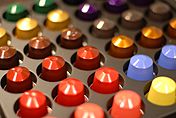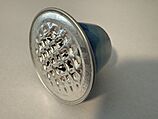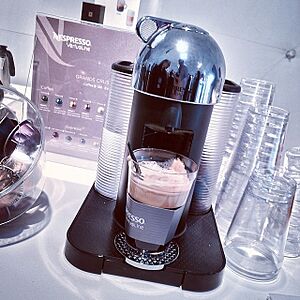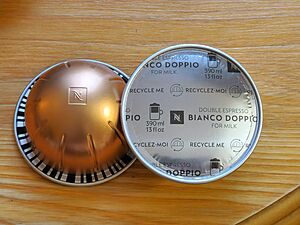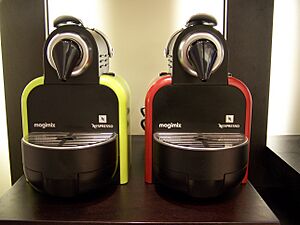Nespresso facts for kids
 |
|
|
Trade name
|
Nespresso |
|---|---|
| Société anonyme | |
| Founded | 1986 |
| Headquarters | Vevey, Switzerland |
|
Number of locations
|
700+ (2020) |
|
Areas served
|
Worldwide |
|
Key people
|
Guillaume Le Cunff (CEO) |
| Products | Coffee capsules/pods, coffee machines |
|
Number of employees
|
13,500 (2017) |
| Parent | Nestlé S.A. |
Nespresso is a company that makes coffee machines and special coffee capsules. It's part of the Nestlé Group and is based in Vevey, Switzerland. Nespresso machines use small, sealed coffee capsules, also called "pods," to make espresso and other types of coffee. These capsules hold ground coffee beans, and sometimes they have extra flavors.
When you put a capsule into a Nespresso machine, it gets pierced. Then, hot water is pushed through it at high pressure. This makes a single cup of fresh coffee. The name "Nespresso" is a mix of "Nestlé" and "Espresso." It's like how other Nestlé brands got their names, such as Nescafé and Nesquik.
All Nespresso coffee is roasted, ground, and put into capsules in Switzerland. The company sells its machines and capsules all over the world. They also have a special system called VertuoLine in North America and some other countries.
Contents
How Nespresso Started
In 1975, a man named Eric Favre worked for Nestlé. He noticed a coffee shop in Rome that had many more customers than others. He found out that the baristas there would pump the espresso machine many times. This pushed water and air into the coffee, making it taste better and creating a foamy top called crema.
Favre used this idea to invent the Nespresso system. He created sealed pods that kept the coffee fresh. When used, the pods allowed more air to mix with the coffee, similar to the pumping action he observed. The machine would pierce the capsule and push hot, pressurized water through it. This made the coffee flow out, creating a delicious espresso.
The Nespresso system was patented by Nestlé in 1976. The first machines were complex and took a decade to be ready for the market. Nespresso first tested its idea in Japan in 1986. That same year, it launched for customers in Switzerland, France, Italy, and Japan.
A decade later, the product became much more successful. This was partly thanks to Jean-Paul Gaillard. He created the Le Club community, which helped Nestlé understand its customers better. He also made the machines cheaper but increased the price of the capsules. Nespresso changed from being mainly for offices to a luxury brand for homes. Other companies were also allowed to make Nespresso machines.
In 1990, Nestlé partnered with Turmix to sell Nespresso machines in Switzerland. Later, they worked with other companies like Krups, Magimix, Alessi, Philips, Siemens, and De'Longhi. Nespresso started as an online business. Its first store, called a boutique, opened in Paris in 2000. Today, Nespresso has over 800 boutiques in many cities worldwide.
Eric Favre, who invented the system, and Jean-Paul Gaillard, who made it a big success, had some disagreements. Favre left Nestlé in 1990. Gaillard also left in 1997. In 2008, Gaillard started his own company that sold biodegradable capsules that worked with Nespresso machines.
In 2022, Nespresso became a certified B Corporation. This means they meet high standards for social and environmental performance.
The Nespresso System
Coffee Machines
Nespresso sells many different coffee machines. Most of these machines are made in Europe by a Swiss company called Eugster/Frismag. This company makes machines for well-known brands like Krups, Breville, and DeLonghi. DeLonghi makes the Lattissima models in Italy. Since 2000, Nespresso has also sold machines with its own "Nespresso" brand name. There are many models, from simple ones like the Inissia to more advanced ones.
Coffee Capsules
Nespresso capsules used to be sold only by Nespresso. They were more expensive than regular ground coffee. However, because the capsules are sealed, the coffee stays fresh for a long time. Nespresso offers many different types of coffee capsules, including both arabica and robusta beans. They also release special "Limited Edition" flavors throughout the year.
Now that Nespresso's original patents have expired, other companies can make capsules that work with Nespresso machines. You can find these third-party capsules and even refillable ones in some stores.
Each capsule holds about 5 to 7 grams of ground coffee. This is enough for one serving. You can make a small 40 ml Espresso shot or a larger 110 ml Lungo (long) coffee. Nespresso capsules are made of aluminium. Many third-party capsules use plastic or other materials. To make sure the aluminum is safe, Nespresso capsules have a food-grade lining inside.
For businesses and offices, Nespresso has a different system with special pad-shaped capsules. These are not the same as the ones for home machines.
How the Coffee is Made
Nespresso capsules are sealed to keep the coffee fresh. When you put a capsule into the machine and close the lever, the capsule is pierced. Some machines make one large hole, while others make three smaller ones.
When you start the machine, it pumps hot water under high pressure into the capsule. This causes the thin foil at the bottom of the capsule to break open. The base where the capsule sits has raised squares that help the foil break at specific points. The brewed coffee then flows out through these holes and into your cup. There's a safety valve inside the machine to prevent too much pressure from building up. This process also creates a foamy layer on top of the coffee called crema, which is made of tiny air bubbles mixed with the coffee's natural oils.
VertuoLine System
In February 2014, Nespresso launched a new system called "VertuoLine" in the United States and Canada. This system was designed for people who prefer larger cups of coffee than the original Nespresso machines made. The VertuoLine system can make different sizes of coffee, from Espresso (40ml) to Alto XL (414ml). Nespresso has over 25 special blends for VertuoLine capsules. These capsules only work with VertuoLine machines, not the original Nespresso machines (now called "OriginalLine"). Nespresso sells both OriginalLine and VertuoLine machines and capsules in North America.
The VertuoLine system uses two special technologies. First, it uses "Centrifusion," which means it spins the capsule inside the machine very fast (up to 7,000 rotations per minute). This helps mix the coffee grounds and hot water. Second, each capsule has a barcode on its rim. The machine scans this barcode to know how to brew the coffee perfectly. It reads things like how fast to spin, the water temperature, how long to brew, and how much water to use. Some people think this barcode system is a way for Nestlé to keep other companies from making compatible capsules.
The VertuoLine system was created to offer coffee similar to the American style of filtered coffee. This helped Nespresso grow its market in North America. In 2013, Nespresso had a small share of the single-serve coffee market in the United States and Canada compared to other brands. In Europe, however, Nestlé had a much larger share.
Initially, Nespresso didn't plan to sell VertuoLine outside North America. But in 2016, they launched it in France under the name "Vertuo." Later, it was introduced in other countries like the United Kingdom, Germany, Switzerland, and Australia. By 2018, Nespresso planned to bring VertuoLine to eight more European markets. In September 2019, the VertuoLine system, called "Vertuo," also launched in the Middle East in Kuwait, UAE, and KSA.
Business Approach
Patents and Brand Image
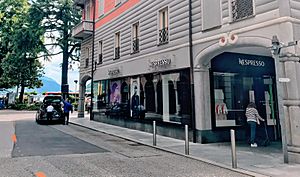
For a long time, Nespresso had many patents that protected its system. This meant that only Nespresso could make and sell the capsules that worked with their machines. This is similar to how printer companies make sure you buy their ink cartridges.
Nespresso's patents started to expire in 2012. This allowed other companies to start making capsules and machines that worked with the Nespresso system. To stay competitive, Nespresso focused on its brand image and customer service. They created the Nespresso Club and opened Nespresso stores. These places offered great customer service and were where most customers bought their capsules. This helped Nespresso keep its image of being exclusive and high-quality.
Famous actor George Clooney has been in Nespresso ads since 2006. The company says he was chosen by their club members to be the brand's ambassador. This kind of advertising helps show that the brand is special and high-status.
Market Growth
Coffee sold in single-serve portions, like Nespresso capsules, has become one of the fastest-growing parts of the coffee market. In Europe, it makes up a large portion of ground coffee sales. In 2010, Nespresso sales had been growing by about 30% each year for the past decade. By then, over 20 billion capsules had been sold since 2000. In 2011, Nespresso reported annual sales of 3 billion Swiss francs.
Cost of Coffee
Nespresso gets most of its coffee through a program called the Nespresso AAA Sustainable Quality Program. In 2017, the company said that 82% of its coffee beans came from this program. In the US, Nespresso capsules usually cost between $0.70 and $2.40 for special limited editions. In Europe, capsules were around €0.35 in the Netherlands.
Advertising Campaigns
George Clooney is well-known as the "face of Nespresso." He has been in their advertisements since 2006, first in Europe and then in the US starting in 2015. In these ads, Clooney has appeared with other actors like John Malkovich, Danny DeVito, and Matt Damon.
In the summer of 2020, during the COVID-19 pandemic, Nespresso released an online ad about sustainability on their YouTube channel.
Competitors
Machines
In August 2011, an Australian company called Kogan announced a coffee machine called the "Ez-press." This machine was designed to work with Nespresso pods.
Capsules
In 2008, Jean-Paul Gaillard, a former CEO at Nespresso, started a company called Ethical Coffee Company SA (ECC). This company made biodegradable capsules that worked with Nespresso machines. However, ECC stopped selling these capsules in 2017.
In March 2016, Starbucks announced that it would sell Nespresso-compatible capsules in Europe. These capsules were designed to work with all Nespresso home machines. Later, Nestlé bought the rights to sell Starbucks coffee products in stores and wholesale. In May 2019, Starbucks and Nestlé officially launched Starbucks Nespresso capsules.
Environmental Impact
Each Nespresso capsule creates about 1 gram of aluminum waste if it's not recycled. Recycling aluminum uses much less energy than making new aluminum. At first, Nespresso didn't have many recycling programs outside of Switzerland. This led to concerns about waste. By 2017, Nespresso had set up capsule collection systems in 36 countries. Countries like France and Switzerland, where Nespresso is very popular, have more accessible recycling facilities.
Globally, about 24.6% of Nespresso capsules are recycled. However, the company says it has the ability to recycle 100% of its capsules through its programs. Nespresso launched a program called "écolaboration" to improve recycling and sustainability. After meeting its goals in 2014, they started a new program called "The Positive Cup." This program focuses on getting coffee from sustainable sources through the Nespresso AAA Sustainable Quality Program, which was developed with the Rainforest Alliance. Nespresso claims to help farmers by teaching them good farming practices and offering them better prices for their coffee beans. About 75,000 farmers from 12 countries are part of this program.
In 2019, Nespresso worked with a Swedish company called Vélosophy to create a bicycle made from recycled Nespresso pods. They also worked with Caran d'Ache to make a ballpoint pen from recycled coffee pods.
Nespresso Professional, OriginalLine, and VertuoLine capsules can be recycled at Nespresso's recycling centers. In 2023, Nespresso introduced paper-based coffee pods in France and Switzerland. These can be recycled with biodegradable waste.
Recycling Bags
Nespresso provides free recycling bags to customers. You can get them in stores or with online orders. A sealed recycling bag can hold up to 100 VertuoLine capsules or 200 OriginalLine capsules. You don't need to rinse or empty the capsules before putting them in the bag. In the United States and United Kingdom, customers can give their full recycling bags to the postman who delivers their Nespresso order. You can also drop them off at a UPS store, a Nespresso store, or other partner locations. Since June 2018, customers in most Canadian provinces can mail in their full recycling bags for free through Canada Post. Residents of British Columbia and Quebec can put their full bags in their regular recycling bin for curbside pickup.
Nespresso's First Non-Coffee Product: Nespresso Bloom Honey
Nespresso has started selling products other than coffee. They introduced "Nespresso Bloom," which includes Coffee Blossom Honey and Coffee Blossom Honey Syrup. These products come from the same coffee plants used for Nespresso's Master Origins Colombia coffee. They are made to go well with Nespresso coffee and can also be used in other foods and drinks. This project supports Nespresso's goal of sustainable coffee farming and helping pollinators like bees, which are very important for coffee plants. The Nespresso Bloom products were developed at Nestlé's R&D Accelerator in Switzerland and are available in limited amounts at some Nespresso stores and online.
Legal Challenges
In March 2011, a Swiss supermarket called Denner won a court case against Nestlé. Denner was selling plastic capsules that worked with Nespresso machines for about half the price of Nespresso's own capsules.
By 2014, Nespresso had been in more legal fights with other companies over coffee pods in countries like the UK, Germany, France, Belgium, and the Netherlands. One news report said that "Nestlé has lost in just about every one of those conflicts." In France, which was Nespresso's biggest market, the antitrust watchdog said that Nespresso might have used its strong position unfairly. They suggested that Nespresso made customers buy their capsules to use with their machines, which could stop other companies from selling rival capsules. Nespresso agreed to stop making machine warranties depend on using only Nespresso pods. They also agreed to remove warnings against using third-party pods.
See also
 In Spanish: Nespresso para niños
In Spanish: Nespresso para niños
- Single-serve coffee container
- Coffee wars
- Dolce Gusto
- Handpresso
- Senseo
- Caffitaly



